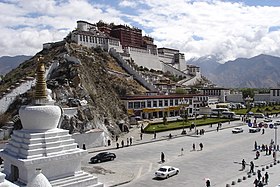Potala
| Potala | |
|---|---|
|
| |
| པོ་ཏ་ལ (bo) | |
|
palaciu, atraición turística, Dzong (es) | |
 | |
| Llocalización | |
| País | |
| Rexón autónoma | Rexón Autónoma del Tíbet |
| Ciudá-prefeutura | Lhasa |
| Distritu | Chengguan (es) |
| Coordenaes | 29°39′28″N 91°07′01″E / 29.657777777778°N 91.116944444444°E |
| Historia y usu | |
| UNESCO World Heritage Site record modification (en) | 2000, 2001 |
| Usu | residencia oficial |
| Arquiteutura | |
| Altor | 117 m |
| Anchor | 350 m |
| Llargor | 400 m |
| Superficie | 13 ha |
| Patrimoniu de la Humanidá | |
| Criteriu | (i), (iv) y (vi) |
| Referencia | 707-001 |
| Rexón | Asia y Oceania |
| Inscripción | ) |
El Potala o templu de Lhasa ye la máxima espresión de l'arquiteutura tibetana y residencia de los Dalái Lama desque Lozang Gyatso fundar nel sieglu XVII (añu 1648) en Lhasa, la capital del Tíbet, hasta 1959, fecha na que'l decimocuartu Dalai Lama se exilió a Dharamsala, India, tres una revuelta popular contra China.
El monumentu asítiase sobre'l monte llamáu Hongshan, a un altor de 3.650 metros sobre'l nivel del mar. Toma una área de 410.000 metros cuadraos y tien una superficie edificada de 130.000 metros cuadraos.
Foi clasificáu como Patrimoniu de la Humanidá pola Unesco nel añu 1994. Esta declaración foi ampliada nos años 2000 y 2001 pa tomar a los monumentos vecinos del Palaciu Norbulingka y el Templu de Jokhang.
El Palaciu Blanco
[editar | editar la fonte]El Palaciu Blanco o Potrang Karpo constitúi la residencia del Dalái Lama. Empezó a construyise mientres el gobiernu del Quintu Dalái Lama, treslladándose equí col so gobiernu en 1649. A empiezos del sieglu XX algamó les sos dimensiones actuales gracies a la reforma efectuada pol decimotercer Dalái Lama. El palaciu siempres tuvo usos seculares, conteniendo habitaciones, oficines, un seminariu y una casa d'imprenta. Un patiu central conocíu como Deyangshar dixebra les habitaciones del Dalái Lama y de los sos monxos del Palaciu Coloráu, la parte del Potala dedicada dafechu al estudiu y l'oración. Este contién la stupa dorada del octavu Dalái Lama, la sala d'asamblees monacal, numberoses capiyes y santuarios, y biblioteques con importantes escritos budistes, como la Kangyur, con 108 volumes, o la Tengyur, con 225. L'edificiu mariellu al llau del Palaciu Blanco alluga les grandes banderes con símbolos sagraos que se colgar na fachada meridional mientres los festivales d'Añu Nuevu.
- Potala
Ver tamién
[editar | editar la fonte]Referencies
[editar | editar la fonte]Enllaces esternos
[editar | editar la fonte]- Palaciu Potala Archived 2006-11-08 at the Wayback Machine
Text is available under the CC BY-SA 4.0 license; additional terms may apply.
Images, videos and audio are available under their respective licenses.







